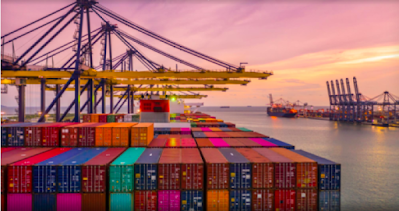One of the great innovations of the 20th century was the sea/land container that is used for international shipping.
 |
| Credit: https://www.veconinter.com/blog/post/types-of-shipping-containers-and-their-use/204 |
The concept of the modern intermodal shipping container was the brainchild of a former North Carolina truck driver by the name of Malcom McLean who went on to own a trucking company.
His “big box” idea, which has revolutionized cargo handling worldwide, came to him in 1937 while he waited most of the day to deliver cotton bales on his truck to a pier in New Jersey.
“Suddenly it occurred to me: Would it not be great if my trailer could simply be lifted up and placed on the ship without its contents being touched?”
De Haas goes on to explain that the subsequent development of container shipping in the 1950s and 1960s was largely an American affair featuring McLean.
Boxes similar to modern containers had already been used in rail applications. What was new in the revolutionary ideas presented by McLean was the belief that efficiency could be vastly improved through intermodal containers and his perseverance in making it happen.
McLean converted the World War II tanker Potrero Hills to a ship capable of carrying containers and rechristened her the Ideal X. She made her maiden journey on April 26, 1956, sailing from Newark to Houston carrying 58 metal containers and 15,000 tons of petroleum.
McLean grew into shipowning with his company Sea-Land. Initially the containers were loaded on their chassis, but later the chassis was left behind, enabling containers to be stacked.
90% of international shipping now utilizes shipping containers. They are indispensable in international trade. Almost anything you buy that has been manufactured overseas will have gotten to you by way of a shipping container.
Based on the rental costs of these containers, you are likely to soon see higher costs for any of those items you buy as prices to rent them have soared recently. It is yet another indication, as I wrote recently, that inflation may be in every American consumer's future.
Here is the Drewry World Container Index for the week of June 24.
It increased 15.9% in the last week alone. That is also 4x what it was a year ago.
 |
| Source: Drewry World Container Index |
However, look at the spot prices for containers from Shanghai to New York and Los Angeles.
Prices from Shanghai to New York surged 39% in the last week alone. The increase from Shanghai to Los Angeles was up 34%.
Note that the price to rent a container to send goods from LA to Shanghai is only $1,000. A pretty clear example of supply and demand. There is a lot coming in from China. There is not much going back.
What is causing the price increases?
China goods have been in demand from the United States and Europe as consumers started buying coming out of the pandemic. At the same time, China (where 90% of all shipping containers are made) was not making any new containers during the pandemic. In the United States, ports have not been able to get enough workers to return to work and it takes time to train new workers. In the meantime, ships and containers have been building up in U.S. ports.
Ocean carriers that own or lease most of the containers in use are aggressively trying to get boxes back to Asia from the U.S., according to Ken Hoexter, a transportation industry analyst at Bank of America in New York. But the current tightness in transportation markets will continue at least through the middle of the year or later, he said in an interview last week.
The shipping industry is trying to play catchup but the combination of extremely low inventories, port congestion in the U.S., increasing consumer demand, the lack of any downtime in China during the curtailed Lunar New Year and now the Biden administration’s $1.9 trillion stimulus package will extend the shortages, he said.
It appears that it is going to get worse before it gets better.
Here is someone on Twitter stating they were quoted $20,000 for a shipping container. They were paying $3,000.
It appears to me that everyone should be bracing for price increases on any products that are imported. Increases of this magnitude simply can't be absorbed by the importer.
I would guess as well that most of the price increases as a result of these shipping cost increases will hit just as we head into the Christmas buying season.
You might want to shop early this year.
What are the goods that will be most affected by the increase in shipping costs?
Anything that is imported, particularly those items from China and Asia which we rely on in which there is no significant American competition.
High value, low weight items like computer chips, phones and computer parts will not be affected as much as lower value and/or heavier products like furniture, clothing, toys, small tools, electrical appliances etc. The high value, low weight items more typically can be shipped via air freight. The latter categories rely on those shipping containers.
In addition, many of the manufacturing and electrical machinery parts for U.S. businesses are shipped in those containers from China. These are the largest dollar import categories coming from China. The shipping container issue may also end up resulting in disruptions in other business categories much as we have seen with how the computer chip shortage has impacted the automobile manufacturers.
The shipping container issues is another reminder of the risks of long supply chains that extend to China.
It seems like I remember that we had a President at one time who warned about an over reliance on China.
Many people may soon feel the costs of that reliance in much higher costs.
The sad fact is that so few will even understand what is happening to them.
You can bet they will be told that it is Trump's fault.



No comments:
Post a Comment